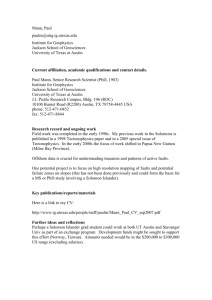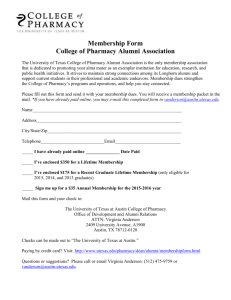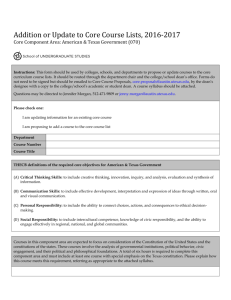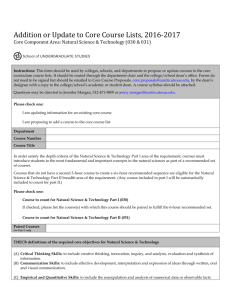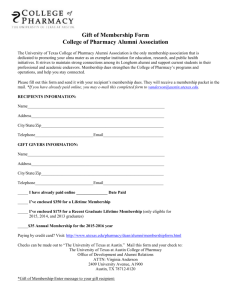Reference Guide - The Learning Record
advertisement
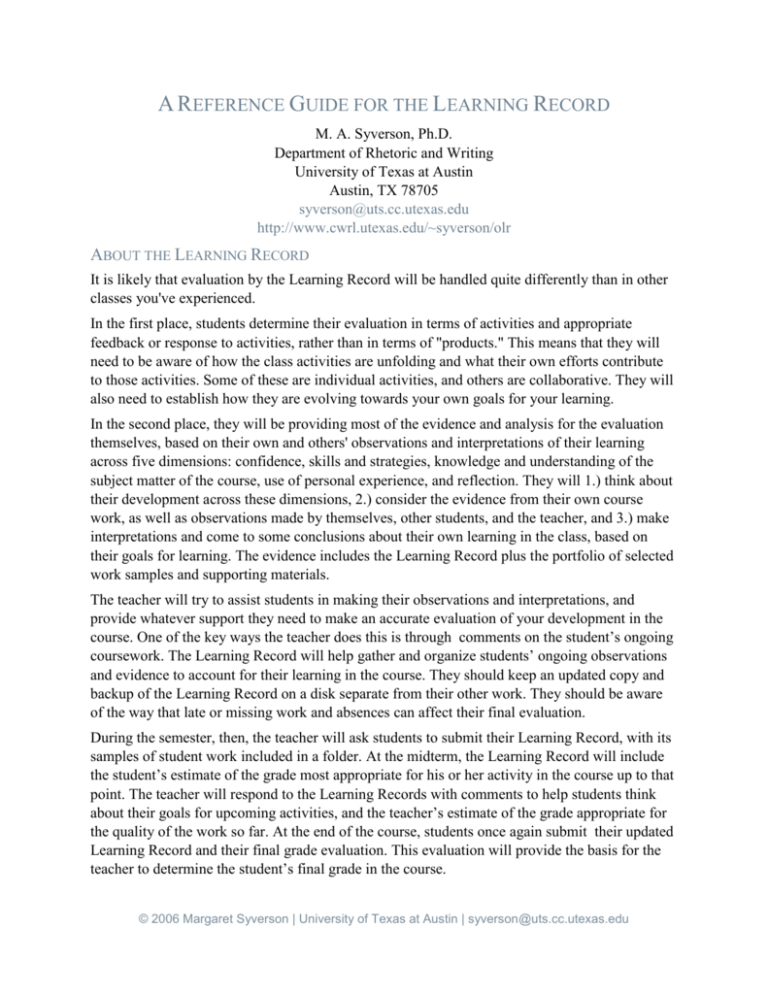
A REFERENCE GUIDE FOR THE LEARNING RECORD M. A. Syverson, Ph.D. Department of Rhetoric and Writing University of Texas at Austin Austin, TX 78705 syverson@uts.cc.utexas.edu http://www.cwrl.utexas.edu/~syverson/olr ABOUT THE LEARNING RECORD It is likely that evaluation by the Learning Record will be handled quite differently than in other classes you've experienced. In the first place, students determine their evaluation in terms of activities and appropriate feedback or response to activities, rather than in terms of "products." This means that they will need to be aware of how the class activities are unfolding and what their own efforts contribute to those activities. Some of these are individual activities, and others are collaborative. They will also need to establish how they are evolving towards your own goals for your learning. In the second place, they will be providing most of the evidence and analysis for the evaluation themselves, based on their own and others' observations and interpretations of their learning across five dimensions: confidence, skills and strategies, knowledge and understanding of the subject matter of the course, use of personal experience, and reflection. They will 1.) think about their development across these dimensions, 2.) consider the evidence from their own course work, as well as observations made by themselves, other students, and the teacher, and 3.) make interpretations and come to some conclusions about their own learning in the class, based on their goals for learning. The evidence includes the Learning Record plus the portfolio of selected work samples and supporting materials. The teacher will try to assist students in making their observations and interpretations, and provide whatever support they need to make an accurate evaluation of your development in the course. One of the key ways the teacher does this is through comments on the student’s ongoing coursework. The Learning Record will help gather and organize students’ ongoing observations and evidence to account for their learning in the course. They should keep an updated copy and backup of the Learning Record on a disk separate from their other work. They should be aware of the way that late or missing work and absences can affect their final evaluation. During the semester, then, the teacher will ask students to submit their Learning Record, with its samples of student work included in a folder. At the midterm, the Learning Record will include the student’s estimate of the grade most appropriate for his or her activity in the course up to that point. The teacher will respond to the Learning Records with comments to help students think about their goals for upcoming activities, and the teacher’s estimate of the grade appropriate for the quality of the work so far. At the end of the course, students once again submit their updated Learning Record and their final grade evaluation. This evaluation will provide the basis for the teacher to determine the student’s final grade in the course. © 2006 Margaret Syverson | University of Texas at Austin | syverson@uts.cc.utexas.edu Learning Record Reference Guide • 2 What is the Learning Record? The Learning Record (LR) is a system for gathering, organizing, analyzing, evaluating, and reporting evidence of student progress and achievement. While it offers a consistent structure for organizing and presenting this evidence, it does not constrain either the contents or the methods by which the evidence is produced. The principles of the LR model include review of diverse forms of data about student learning over time in the course of regularly occurring class activities, including samples of student work and observations that focus on what students demonstrate they know and can do. The process of keeping the Learning Record begins by establishing the student’s background from two sources: an interview with a parent or someone who knows the student well, and the student’s reflections about his or her development (Part A). The next step is to gather ongoing evidence of learning in two forms: work samples, for which virtually any kind of evidence can be included in the LR, including tape recordings of performances, drafts of papers, sketches and diagrams, diagnostic test results, quizzes or exams, links to online materials, and other samples of student work. The second form of evidence is observations of students’ activity gathered over the semester providing insights into their experiences and activities in the class. In the analysis portion of the LR (Part B), this evidence is interpreted in terms of the strands of work in the course (its objectives) and five dimensions of learning: confidence and independence knowledge and understanding skills and strategies the use of prior and emerging experience reflectiveness In the final section of the LR (Part C) students develop an evaluation, comparing the evidence in the LR with grade criteria defined by the instructor. The instructor responds to the evidence, the analysis, and the student's estimated grade with the final evaluation. Thus, the LR is well-suited to assess collaborative work, creative inquiry, online projects, and other kinds of work that are usually considered difficult to evaluate. It is also well suited for evaluating students who come into the class with different sets of skills and background experience, or physical or learning disabilities. © 2006 Margaret Syverson | University of Texas at Austin | syverson@uts.cc.utexas.edu Learning Record Reference Guide • 3 THE LEARNING RECORD STUDENTS’ FREQUENTLY ASKED QUESTIONS 1. What is the Learning Record OnlinE? The Learning Record (LR) is a systematic way to document your activity in the class throughout the term so that you and your instructor can better evaluate your learning. 2. How do I access the Learning Record? Do I need any special programs or equipment? Your teacher will provide the Learning Record for you. The only thing you need to access the Learning Record is a computer with a Microsoft Word or any word processing application. It is helpful to have an email account, if you are going to submit work to your teacher via email. 3. Do I need a special account or password? No. 4. What do I do first? First make a copy of the Learning Record document. Look at the course information to be sure it is correct, and add any necessary information. Create your student profile by adding your information to the student profile section. Indicate any language proficiencies you have in this section. Save the Learning Record as your teacher instructs. Then visit each of the other sections of the Learning Record just to get familiar with the way it is organized. 5. What are the parts of the Learning Record, and what are they for? The Learning Record is organized into six parts: Student profile, which provides basic information such as your name, email address, and language proficiencies Background (Part A), which consists of information about your development in reading, writing, speaking and listening prior to the class. This information is gathered both from a parent or someone who knows you well (Part A.1) and from you (Part A.2). Usually, your instructor will ask you to conduct the interview and write a summary for part A.1. This section is completed at the beginning of the term. Observations, which consist of brief “snapshots” of what you’ve observed about your activity related to the class or course goals, gathered over the course of the term. Samples of work, selections from the work you’ve done in the course. These samples should include both formally assigned work such as papers or projects, as well as informal work such as lab notes, diagrams, rough drafts, email with collaborative partners, or other work that demonstrates your development over the course term. Analysis (Part B), which is completed both at the midterm (Part B.1) and at the end of the term (Part B.2). Reviewing your observations and samples of work in the light of Part A (where you © 2006 Margaret Syverson | University of Texas at Austin | syverson@uts.cc.utexas.edu Learning Record Reference Guide • 4 started the course), provide an interpretation of your learning in terms of the course strands and the five dimensions of learning (described below). Evaluation (Part C), which is also completed both at midterm (Part C.1) and at the end of the term (Part C.2). Comparing your observations, samples of work, and analysis in Part B with the grade criteria for the course, provide an evaluation and an estimate of the grade represented by the evidence in the Learning Record. The evaluation helps you develop a clearer sense of your progress and development based on sound evidence. 6. What are the “course strands” and the “dimensions of learning”? Course strands are the specific goals or objectives of a particular course, as established by the instructor. For example, in writing courses taught in a computer classroom, course strands might be rhetoric, research, technology, and collaboration. These are areas in which instructors and students can expect to see evidence of development. Dimensions of Learning are five aspects of learning that can be observed in any subject. They are dependent on each other: typically when students make gains in one or two of these dimensions the other dimensions also develop. The five dimensions include: Confidence and independence Skills and strategies Knowledge and understanding The use of prior and emerging experience Reflectiveness Together with the course strands, the dimensions of learning give students and instructors a set of shared concepts for interpreting and discussing students’ development. They are explained in more detail below. 7. What are moderation readings? Moderation readings can be held either with students in a particular class or with instructors from several classes. In pairs, readers examine a Learning Record and discuss the evidence and interpretations with each other. Students’ and teachers’ evaluations and identities are masked. Based on the evidence, the course grade criteria, and their discussions, the pairs of readers evaluate the Learning Record and determine what grade they would assign. They also provide helpful comments for the Learning Record author. This process helps readers develop their understanding of the relationship between evidence, interpretation, and evaluation. It helps ensure fairness in the evaluation process. And it helps teachers and students learn from each other. Because moderation readings conducted by teachers are public, there is no secrecy in the process. Students, policy makers, other teachers, and administrators can observe the moderations and provide feedback on the process. For more information about moderations see http://www.cwrl.utexas.edu/~syverson/olr/moderations © 2006 Margaret Syverson | University of Texas at Austin | syverson@uts.cc.utexas.edu Learning Record Reference Guide • 5 8. Why is this system better than conventional grading? We believe that conventional grading does not provide useful information either for students about their performance or for teachers who hope to improve their teaching. The Learning Record helps both teachers and students get a clearer picture of students’ learning over the course of the term. It also makes it possible for students to account for experimental work that may not turn out as well as hoped in the final project, or “invisible” work such as collaborative efforts. As long as the observations and analysis show that students have learned something significant from such experiments or collaborative work, the Learning Record can support a more positive evaluation than conventional grading. For more information see http://www.cwrl.utexas.edu/~syverson/olr/compare.html 9. I’m confused. What is due, and when, for the LR? Your instructor will give you specific dates. Here’s a general guide: At the beginning of the term: Check the student information page. Conduct the Part A.1 interview with a parent or someone who knows you well. Add your own reflections about your development in Part A.2. Throughout the term: Add brief observations about your activity related to the class. Two or three a week should be sufficient. Add each example of your work to the work samples section of the LRO as it is completed. At the midterm: Review Part A, your observations, and work samples. Decide which observations and work samples you would like to include in the Learning Record. Complete the Midterm Analysis (Part B.1). Review the grade criteria for the course and complete the Midterm Evaluation (Part C.1). At the end of the term: Review Part A, your observations, and work samples. Decide which observations and work samples you would like to include in the Learning Record. Complete the Final Analysis (Part B.2). Review the grade criteria for the course and complete the Final Evaluation (Part C.2). 10. How can I learn more about the Learning Record? There is more information about the Learning Record available online for students and teachers at the main Learning Record web site (http://www.cwrl.utexas.edu/~syverson/olr). © 2006 Margaret Syverson | University of Texas at Austin | syverson@uts.cc.utexas.edu Learning Record Reference Guide • 6 FIVE DIMENSIONS OF LEARNING Learning theorists have argued that learning and development are not like an assembly-line which can be broken down into discrete steps occurring with machine-time precision, but an organic process that unfolds in complex ways according to its own pace and rhythm. Teaching and learning occurs in complex ecosystems, dynamic environments where teachers, students, materials and supplies, texts, technologies, concepts, social structures, and architectures are interdependently related and interactive. Using the Learning Record, teachers (and students) are actively searching for, and documenting, positive evidence of student development across five dimensions: confidence and independence, knowledge and understanding, skills and strategies, use of prior and emerging experience, and critical reflection. These five dimensions cannot be "separated out" and treated individually; rather, they are dynamically interwoven. Our goals for a particular class should describe a trajectory of learning across multiple dimensions, and our measurements should be able to identify the paths taken by students and their progress from their individual starting points along that trajectory. Individually, learners can expect to make progress across these five dimensions: Confidence and independence We see growth and development when learners' confidence and independence become congruent with their actual abilities and skills, content knowledge, use of experience, and reflectiveness about their own learning. It is not a simple case of "more (confidence and independence) is better." In a science class, for example, an overconfident student who has relied on faulty or underdeveloped skills and strategies learns to seek help when facing an obstacle; or a shy student begins to trust her own abilities, and to insist on presenting her own point of view in discussion. In both cases, students are developing along the dimension of confidence and independence. Skills and strategies Skills and strategies represent the "know-how" aspect of learning. When we speak of "performance" or "mastery," we generally mean that learners have developed skills and strategies to function successfully in certain situations. Skills and strategies are not only specific to particular disciplines, but often cross disciplinary boundaries. In a writing class, for example, students develop many specific skills and strategies involved in composing and communicating effectively, from research to concept development to organization to polishing grammar and correctness, and often including technological skills for computer communication. Knowledge and understanding Knowledge and understanding refers to the "content" knowledge gained in particular subject areas. Knowledge and understanding is the most familiar dimension, focusing on the "knowwhat" aspect of learning. In a psychology class, knowledge and understanding might answer a wide range of questions such as, What is Freud's concept of ego? Who was Carl Jung? What is "behaviorism"? These are typical content questions. Knowledge and understanding in such classes includes what students are learning about the topics; research methods; the theories, © 2006 Margaret Syverson | University of Texas at Austin | syverson@uts.cc.utexas.edu Learning Record Reference Guide • 7 concepts, and practices of a discipline; the methods of organizing and presenting our ideas to others, and so on. Use of prior and emerging experience The use of prior and emerging experience involves learners' abilities to draw on their own experience and connect it to their work. A crucial but often unrecognized dimension of learning is the capacity to make use of prior experience as well as emerging experience in new situations. It is necessary to observe learners over a period of time while they engage in a variety of activities in order to account for the development of this important capability, which is at the heart of creative thinking and its application. With traditional methods of evaluating learning, we cannot discover just how a learner's prior experience might be brought to bear to help scaffold new understandings, or how ongoing experience shapes the content knowledge or skills and strategies the learner is developing. In a math class, students scaffold new knowledge through applying the principles and procedures they've already learned: algebra depends on the capacity to apply basic arithmetic procedures, for example. Reflection Reflection refers to the developing awareness of the learner's own learning process, as well as more analytical approaches to the subject being studied. When we speak of reflection as a crucial component of learning, we are not using the term in its commonsense meaning of reverie or abstract introspection. We are referring to the development of the learner's ability to step back and consider a situation critically and analytically, with growing insight into his or her own patterns and learning processes, a kind of metacognition. It provides the "big picture" for the specific details. For example, students in a history class examining fragmentary documents and researching an era or event use reflection to discover patterns in the evidence and construct a historical narrative. Learners need to develop this capability in order to use what they are learning in other contexts, to recognize the limitations or obstacles confronting them in a given situation, to take advantage of their prior knowledge and experience, and to strengthen their own performance. © 2006 Margaret Syverson | University of Texas at Austin | syverson@uts.cc.utexas.edu Learning Record Reference Guide • 8 LEARNING RECORD PRIVACY POLICY Please read carefully! The Learning Record is a public record that documents your activities and accomplishments for this class. However, no one except you and your instructor will have access to identifying personal information, such as your name or email address. You may request that only your classmates and your teacher may have access to your Learning Record by checking the appropriate box for the privacy question on your Learning Record's front page. ("No"). In your class, you turn in all assigned work so that your teacher can give you credit for it. You keep a portfolio of all of your work as well as the teacher’s responses to it. At the midterm and at the end of the term you review all of your work and select the specific examples of work and observations to include with the Learning Record. You control the content of your Learning Record. Who has access to your Learning Record? What do they have access to and when? During the class term Your teacher has access to all information in your Learning Record that you provide, as well as identifying information (to allow your grade to be assigned) Your classmates. Several of your classmates may have access to the parts of your Learning Record you provide during the peer review process called Moderation Reading. They may have access to work samples for peer review. They will not have access to anything you wish to keep private, or to your Part C Evaluation and grade estimate. After the end of the class term and after final grades have been submitted, Learning Records may be saved to an archive. Information identifying students will be encrypted in the archive; no one will have access to this information. If you have checked the “No” box on your Learning Record profile page, your LR will not be saved for the archive. Researchers will have access to all information in archived Learning Records except student identification information. We expect that the archives may serve as an important resource for research on teaching and learning. Other teachers will have access to all public information in archived Learning Records except student identification information. Teachers read the Learning Records of other teachers in Moderation Readings, which are used for large-scale assessment and professional development. We expect that the archives will be an important resource for preparing new teachers and for professional development of experienced teachers. Administrators will have access to all public information in archived Learning Records except student identification information. We expect that administrators will use the archives to develop, evaluate, and improve programs Educational policy makers will have access to all public information in archived Learning Records except student identification information. We expect that government agencies and other policy makers will use the archives to improve educational policies on a wide © 2006 Margaret Syverson | University of Texas at Austin | syverson@uts.cc.utexas.edu Learning Record Reference Guide • 9 range of issues affecting teachers, students, and educational institutions. We also hope that the archives will help policy makers recognize that the Learning Record model is a powerful and trustworthy alternative to standardized testing. In other words, any archives of student work are intended to support research, professional development of teachers, program evaluation and improvement, and sound public policy. What if I don't want to allow access to my Learning Record by people outside my class? Remember to check the “No” box on the privacy question on your Learning Record's front page. How might material from my Learning Record be used? Learning Record information will only be provided for non-commercial educational use, including: Academic research, including publication in books, articles, conference presentations, and technical papers. Professional development of teachers. Development, evaluation, and improvement of programs. Informing public educational policy. Except for your teacher, no one will have access to any of your identifying information. To ensure confidentiality, be sure to remove any information that identifies you or any classmates from files that you upload to your Learning Record. Use first names only when referring to classmates in your observations or work samples. © 2006 Margaret Syverson | University of Texas at Austin | syverson@uts.cc.utexas.edu
